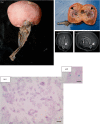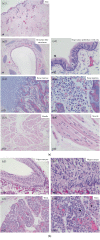Renal Tubular Dysgenesis in a Case of Fetus Acardius Amorphus
- PMID: 31781459
- PMCID: PMC6875321
- DOI: 10.1155/2019/5416936
Renal Tubular Dysgenesis in a Case of Fetus Acardius Amorphus
Abstract
Fetus acardius amorphus is a rare congenital malformation characterized by the lack of a functional heart, the presence of a bivascular umbilical cord, as well as a developed and organized skeletal system and partially organized inner organs. Fetus acardii mostly occur in multiple gestations. The pathogenesis of this entity is not clarified yet. It has been hypothesized that, although formation of anastomosing vessels between the co-twin and the anomalous embryo as well as reverse directed blood flow within the umbilical arteries of the weaker twin may allow sufficient blood flow to form rudimentary internal organs, it is insufficient to develop a fully functional heart. We had a case of fetus acardius amorphus, where we performed autopsy as well as routine histology assessment to identify different types of tissues. We showed that our fetus acardius amorphus demonstrated histomorphological features of renal tubular dysgenesis, confirmed by lack of proximal tubules, extramedullary hematopoiesis and increased number of smooth muscle actin positive vessels. This is a novel finding and has not been reported previously.
Copyright © 2019 C. Thoeni et al.
Conflict of interest statement
The authors declare that they have no conflicts of interest.
Figures




Similar articles
-
Placental teratoma or acardius amorphus with amniotic band syndrome.Eur J Obstet Gynecol Reprod Biol. 1985 Oct;20(4):265-73. doi: 10.1016/0028-2243(85)90075-9. Eur J Obstet Gynecol Reprod Biol. 1985. PMID: 4054420
-
An acephalus acardius amorphous fetus in a monochorionic pregnancy with sex discrepancy.Twin Res Hum Genet. 2006 Oct;9(5):697-702. doi: 10.1375/183242706778553453. Twin Res Hum Genet. 2006. PMID: 17032553
-
Foetus holo-acardius amorphus.Clin Proc. 1947 Sep;6(7):292-9. Clin Proc. 1947. PMID: 20267084 No abstract available.
-
Fetus amorphus or placental teratoma?Teratology. 1989 Jul;40(1):1-10. doi: 10.1002/tera.1420400102. Teratology. 1989. PMID: 2669216 Review.
-
[Acardius or "twin-reversed arterial prefusion" sequence. Report of four cases and review of current therapeutic possibilities].Pathologe. 2000 Jul;21(4):308-14. doi: 10.1007/s002920000372. Pathologe. 2000. PMID: 11006931 Review. German.
Cited by
-
A complementary study approach unravels novel players in the pathoetiology of Hirschsprung disease.PLoS Genet. 2020 Nov 5;16(11):e1009106. doi: 10.1371/journal.pgen.1009106. eCollection 2020 Nov. PLoS Genet. 2020. PMID: 33151932 Free PMC article.
References
-
- Harvey. Acephalous monster at the full period of pregnancy. Lancet. 1848;ii:696
-
- Spliedt. Anatomical description of an acardiac monstrosity. British and foreign medico-chirurgical review. 1860;26:543.
-
- Slyman W. An acephalous acardiac monster of six months’ gestation with rudimentary heart. Transactions of the Obstetric Society of London. 1889;31:258–262.
-
- Wolff B. Über eine Drillingsgeburt mit einem acardius. Archiv für Gynäkologie. 1971;59(2):294–313. doi: 10.1007/BF01833524. - DOI
Publication types
LinkOut - more resources
Full Text Sources

